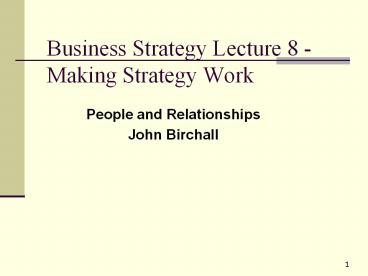Business Strategy Lecture 8 - Making Strategy Work - PowerPoint PPT Presentation
Title:
Business Strategy Lecture 8 - Making Strategy Work
Description:
Business Strategy Lecture 8 - Making Strategy Work People and Relationships John Birchall * Organisational Architecture Concept developed by John Kay (1993 ... – PowerPoint PPT presentation
Number of Views:1254
Avg rating:3.0/5.0
Title: Business Strategy Lecture 8 - Making Strategy Work
1
Business Strategy Lecture 8 - Making Strategy Work
- People and Relationships
- John Birchall
1
2
Linking Purpose to Action
Strategy Context
Broad and Operating Environments
Strategy Content Business Definition, Competitive
Strategies
Organisational Purpose Vision, Mission, Ethics
Strategy Process
Involves Stakeholders
- Adapted from Harrison (2003 37) and De Wit
Meyer (2005 5)
2
3
Organisational Architecture
- Concept developed by John Kay (1993) Foundations
of Corporate Success How Business Strategies Add
Value. Oxford University Press. - Architecture a distinctive capability founded on
relationships - Remember Porters Value Chain?
- Capabilities strengthen the chain
- Co-ordinating the efforts of different functional
departments - Improving communications to improve new product
design, generating extra customer value
4
Link to Porters Value Chain (Harrison 2003 83)
Administration (Firm Infrastructure)
Human resource management
Support activities
Profit
Technology development
Resource procurement
Service
Profit
Marketing and sales
Outbound logistics
Inbound logistics
Operations
Primary activities
4
5
Linking Marketing and Operations
- Long-Range Market Forecasts
- guide decisions about facility size and process
- Marketing Data on Customer Needs
- can help location decisions
- Which is most important? - cost, customer
convenience or access to scarce resources? - Promotions and Ordering Cycles
- should be built into production schedules
- seasonal peaks matter too
6
People and Relationships
- Kay (1993 66) says
- Architectureis a network of relational
contracts within, or around, the firm - Internal architecture relationships of
management with employees, and employees with
each other - External architecture relationships with
suppliers and customers - Networks relationships among a group of firms
engaged in related activities
7
Link to Stakeholder Analysis
LEVEL OF INTEREST
Minimal effort
Keep informed
LOW
POWER
Keep satisfied
Key players
HIGH
LOW
HIGH
- The Mendelow Grid, as shown in
- Johnson, Scholes and Whittington (2005 182)
7
8
External Stakeholders A Positive View (Harrison
2003 268)
Formal Power
High Importance
Economic Power
Partnering and Inclusion in the Firms Activities
Strategic Importance of External Stakeholder
Political Power
Influence on Environmental Uncertainty Facing the
Firm
Monitoring and Traditional Management Techniques
Low Importance
Possession of Knowledge or Resources not Found in
Firm
8
9
Link to Stakeholders and Environmental
Change(Harrison, 2003 37)
The Broad Environment
Technological Influences
Socio-cultural Influences
The Operating Environment
Competitors
Local Communities
Activist Groups
The Organization
Suppliers
Customers
Owners/Board of Directors Managers Employees
The Media
Unions
Financial Intermediaries
Government Agencies and Administrators
Economic Influences
Political/Legal Influences
9
10
Internal Stakeholders
- The world is complex and changing (Stacey 2003)
- Businesses need to avoid complacency, slow
reactions or resistance to change strategic
drift - Junior managers with fresh ideas can stop chief
executives getting set in their ways - Learning is key to success, and often comes from
staff directly involved in operations and sales - Frontline staff can help the organisation develop
proactive strategies to anticipate and shape the
process of change within its industry - Emergent strategy, well directed, can turn the
leaders vision into reality (Mintzberg et al
1998 175-231)
11
A good architecture
- Information flows freely upwards, downwards, and
across functional divisions - People are willing to play with new ideas and
help each other develop them further - Strategy can emerge in flexible response to
issues and challenges - The organisation can learn from its own
experiences and from its stakeholders
12
May be now is the time to collaborate?
- Strategic Alliances
- Joint ventures
- Research partnerships
- Franchising
- Outsourcing
- Start-up assistance, training
13
Supplier value chains
Customer value chains
Channel value chains
Organisations value chain
From Porters Value System
13

